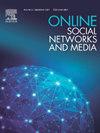Explaining homophily without social selection: The role of transitivity in the formation of homophilic ties
Q1 Social Sciences
引用次数: 0
Abstract
This paper investigates if an assortative social network may further amplify its assortativity following two distinct interventions: linking a random unconnected pair in the neighborhood of a vertex chosen by chance (N-protocol) or connecting a randomly selected open triplet (T-protocol). Under a series of assumptions, we derive a closed-form expression that links the expected change in assortativity caused by N-protocol and the current assortativity score. For the binary nodal characteristic or some other settings, this expression turns out to be a simple quadratic dependency, which indicates that networks with assortative mixing should become less assortative following N-protocol. Next, we provide a sufficient condition that N- and T-protocols will cause the same assortativity change. Using numerical experiments with synthetic and empirical networks with various assortativity rates, we demonstrate that our theoretical estimations tend to be quite accurate for topologies with moderate assortativity. However, for topologies with relatively high assortativity levels, the factual values of the assortativity shift tend to be greater than theoretical ones, but still negative. Empirical topologies are also characterized by relatively large divergences between N- and T-protocols, with the latter typically providing a higher assortativity decrease. We carefully explain these findings by analyzing local homophily patterns. We also consider a modified version of T-protocol that connects individuals having no less than a predefined number of common peers. For a corpus of empirical networks, we managed to characterize the threshold values of assortativity and the number of common friends above which the assortativity rate will increase following this intervention.
本文研究了在两种不同的干预措施之后,同类社会网络是否会进一步扩大其同类性:连接一个随机选择的顶点邻域中的一对未连接的顶点(N 协议)或连接一个随机选择的开放三元组(T 协议)。在一系列假设条件下,我们得出了一个封闭式表达式,它将 N 协议引起的同向性预期变化与当前同向性得分联系起来。对于二元节点特征或其他一些设置,这个表达式变成了一个简单的二次依赖关系,这表明在 N 协议之后,具有同类混合的网络的同类性应该会降低。接下来,我们提供了一个充分条件,即 N 协议和 T 协议将导致相同的同类性变化。通过对具有不同同配率的合成网络和经验网络进行数值实验,我们证明,对于具有中等同配率的拓扑结构,我们的理论估计往往相当准确。然而,对于同化水平相对较高的拓扑结构,同化偏移的实际值往往大于理论值,但仍为负值。经验拓扑的另一个特点是 N 协议和 T 协议之间的差异相对较大,后者通常会带来更高的同类性下降。我们通过分析局部同亲模式仔细解释了这些发现。我们还考虑了一种改进版的 T 协议,它能将具有不少于预定数量的共同同伴的个体连接起来。对于经验网络的语料库,我们设法确定了同质性的临界值和共同朋友的数量,超过这些临界值,同质性率就会增加。
本文章由计算机程序翻译,如有差异,请以英文原文为准。
求助全文
约1分钟内获得全文
求助全文
来源期刊

Online Social Networks and Media
Social Sciences-Communication
CiteScore
10.60
自引率
0.00%
发文量
32
审稿时长
44 days
 求助内容:
求助内容: 应助结果提醒方式:
应助结果提醒方式:


